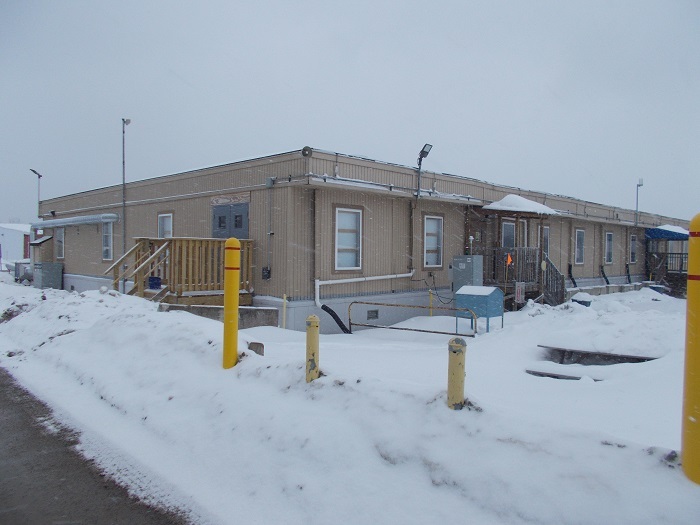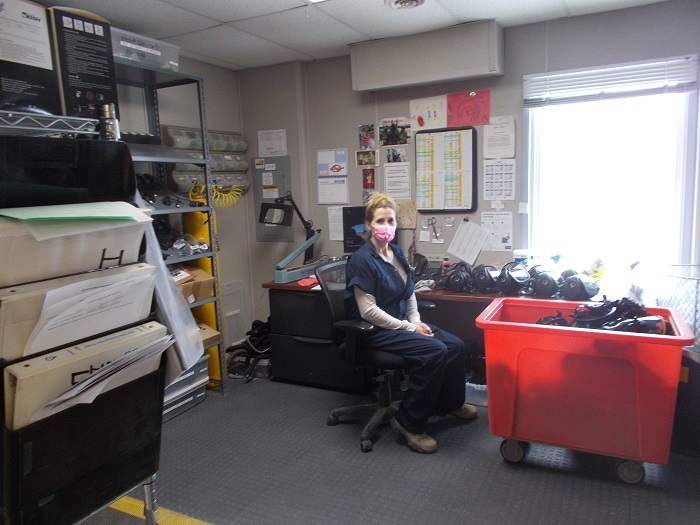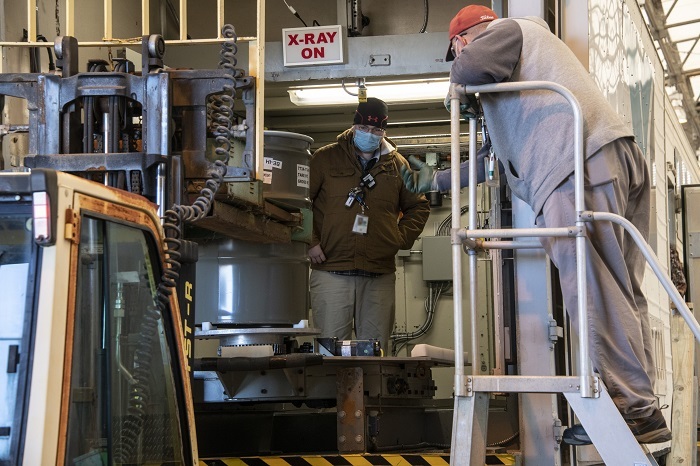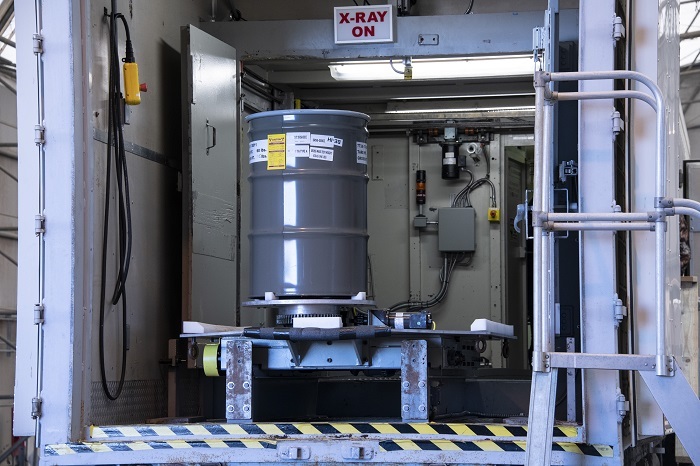 The new Demolition Support Complex will support the West Valley Demonstration Project workforce during the teardown of the former Main Plant Process Building.
WEST VALLEY, N.Y. – EM and its cleanup contractor at the West Valley Demonstration Project (WVDP) have redesigned an office building to support cleanup activities as they prepare to begin the teardown of the former Main Plant Process Building, an EM 2022 priority.
“The reconfiguration of this former office building will provide support for our dedicated workers who will be directly involved in the demolition of the Main Plant,” EM WVDP Director Bryan Bower said. “This facility will become an integral part in helping EM continue its mission of reducing legacy risks and lifecycle costs.”
The building, now called the Demolition Support Complex, includes locker rooms with showers, space for personal protective equipment, a radiation monitoring control room, a respirator issuance room, and a large area for work briefings, meetings and lunch, among other things.
 Dusty Mejak, a plant operator with EM West Valley Demonstration Project cleanup contractor CH2M HILL BWXT West Valley, is shown at work in the respirator issuance room of the new Demolition Support Complex. Respirators are used to protect employees working in areas with potential respiratory hazards.
Workers with contractor CH2M HILL BWXT West Valley will change into protective clothing in the complex before entering the Main Plant demolition work area. After they finish work in that area, they will return to the complex to remove the protective clothing and prepare to leave the site. The building is designed to protect employees and the environment by controlling radiological and industrial hazards.
Previously known as the “10-Plex,” the building was constructed using 10 double-wide office trailers. It housed several employees from different departments who have since moved to other office locations at WVDP.
The five-story, 35,000-square-foot Main Plant was constructed in the 1960s as a commercial reprocessing facility to recover reusable plutonium and uranium from spent nuclear reactor fuel. It operated from 1966 to 1972.
-Contributor: Joseph Pillittere
 DOE Central Characterization Project subcontractor Tyler Watson, left, and Savannah River Nuclear Solutions Operator Norman Sykes load a transuranic waste drum into a real-time radiography unit for characterization at the Solid Waste Management Facility at the Savannah River Site.
AIKEN, S.C. – EM recently installed equipment at the Savannah River Site ( SRS) that ensures continued safe shipment of transuranic (TRU) waste to the Waste Isolation Pilot Plant ( WIPP) for disposal.
Crews at the Solid Waste Management Facility at SRS can now characterize and certify newly generated TRU waste with the addition of a real-time radiography unit, which uses an X-ray system to examine the contents of waste containers. The equipment was installed to meet updated requirements set by the National TRU Program that involve evaluating the containers for chemical compatibility and oxidizing chemicals.
WIPP has robust standards for waste containers permitted for disposal in its underground repository. The examination conducted as part of characterization activities at SRS verifies and validates that waste within each container matches documentation provided by SRS. The examination also allows operators to ensure the containers do not include items prohibited by WIPP without having to open them.
“Operation of this equipment, in conjunction with other TRU waste characterization equipment installed at the Solid Waste Management Facility last year, will allow new TRU waste generated from SRS operations to be certified to the new WIPP standards and ultimately shipped to WIPP,” said Kerri Crawford, Solid Waste Programs manager for Savannah River Nuclear Solutions (SRNS), the managing and operating contractor at SRS.
 Remote operation allows for the characterization of a transuranic waste drum using a real-time radiography unit at the Solid Waste Management Facility at the Savannah River Site. Pictured is DOE Central Characterization Project subcontractor Tyler Watson.
 A transuranic waste drum is ready for characterization in the real-time radiography unit at the Solid Waste Management Facility at the Savannah River Site.
TRU waste, a byproduct of the nation’s nuclear defense program, consists of tools, rags, protective clothing, sludge, soil, and other materials contaminated with radioactive elements that have atomic numbers greater than uranium.
Owned by DOE’s Central Characterization Project (CCP), the real-time radiography unit was previously used by Lawrence Livermore National Laboratory before it was refurbished for use at SRS.
DOE established the CCP to standardize and provide efficiencies in the characterization and certification process at DOE waste generator sites. One of those efficiencies is the deployment of mobile loading units (MLUs) and associated teams to assist waste generator sites. MLUs contain the equipment needed to load waste containers into casks for shipment to WIPP, eliminating the need to develop a DOE-certified loading capacity at each waste generator site.
EM established the National TRU Program to oversee the process of preparing TRU waste from DOE waste generator sites to meet WIPP requirements. This process involves the characterization and packaging of waste at generator sites, followed by the transportation of the waste to WIPP.
-Contributor: Lindsey MonBarren
 Control room operators at Hanford’s Waste Treatment and Immobilization Plant are conducting tests, called “water runs,” on plant systems like this process system vessel where glass-forming materials will be mixed with low-activity tank waste to be fed into the plant’s giant melters for vitrification.
RICHLAND, Wash. – Crews at the Waste Treatment and Immobilization Plant (WTP) have completed the first test to demonstrate that liquids can safely run through and between facilities that will support vitrification, a process that will transform the Hanford Site’s radiological and chemical tank waste into a safe form for disposal.
Commissioning technicians have completed an initial test, called a water run, in a critical system in the Low-Activity Waste (LAW) Facility. The test was done on the melter feed process system vessels, where glass-forming materials will be mixed with low-activity tank waste. The mixture will be fed to large melters and heated to 2,100 degrees Fahrenheit during vitrification.
“Water tests are important for confirming plant systems and equipment are performing safely and within operational requirements for the significant mission ahead,” said Rick Holmes, general manager for Waste Treatment Completion Company, a subcontractor to Bechtel National Inc., the EM Office of River Protection (ORP) prime contractor designing, building and commissioning the WTP.
The technicians tested the process system vessels by remotely filling them with water, running internal agitators, and collecting data, including level and density measurements. The agitators maintain a proper mix of materials inside the vessels before the mixture is transferred to the melters.
“These tests build more momentum toward heating up the first melter and ensuring operational efficiency and effectiveness,” said Mat Irwin, ORP deputy assistant manager for the WTP.
Following melter heatup, technicians will feed simulated waste and glass-forming materials into the melters, a step called cold commissioning, later this year.
As part of the Direct-Feed Low-Activity Waste Program, tank waste and glass-forming materials are mixed, heated and poured into specially designed stainless-steel containers. The containers are then transported a short distance to the site’s Integrated Disposal Facility for disposal. The program is a system of interdependent projects and infrastructure improvements, managed and highly integrated, that must operate together to vitrify the waste.
During full operations, the LAW Facility is designed to vitrify up to 5,000 gallons of low-activity waste each day, equivalent to up to 1.75 million gallons each year.
The WTP facilities can be viewed using the self-guided Hanford Virtual Tour. Information on the commissioning process, including a loss-of-power test and melter heatup, is available on the Journey to Melter Heatup website.
-Contributor: Joan Lucas
|